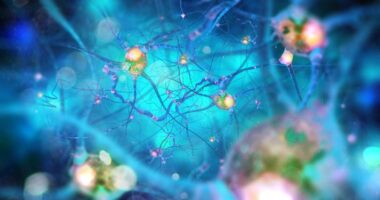Initial steps in huntingtin protein’s toxic folding in Huntington’s found
Study into why only mutations resulting in 36 glutamine repeats cause disease

Scientists have figured out the first molecular events in the formation of toxic huntingtin protein clumps in Huntington’s disease.
The findings shed light about why only mutations that result in at least 36 repeats of glutamine (one of protein’s building blocks) in the huntingtin protein cause the disease — and open new avenues toward possible treatment.
“For three decades, we’ve known that Huntington’s and related fatal diseases occur when proteins contain more than around 36 Qs [glutamines] in a row, causing them to form chains of proteins in the brain, but we didn’t know why,” Randal Halfmann, PhD, the study’s senior author at the Stowers Institute for Medical Research, said in an institute news release. “We’ve now figured out what the first link in the chain looks like, and, in doing so, have discovered a new way to stop it.”
The study, “Pathologic polyglutamine aggregation begins with a self-poisoning polymer crystal,” was published in eLife.
Huntington’s is caused by mutations in the gene that provides instructions for making the huntingtin protein. As a result, cells produce an abnormal huntingtin protein that has a long tail, called the polyQ region, where glutamine is repeated excessively.
Mutated huntingtin protein containing a long polyQ region is known to form clumps, called amyloid aggregates, inside cells. Amyloid clumps made from other proteins are found in other neurodegenerative diseases like Alzheimer’s and amyotrophic lateral sclerosis.
It’s well established that Huntington’s will only develop if there are at least 36 glutamine repeats in the huntingtin protein, but the reason for this numeric cutoff hasn’t been clear, prompting scientists to examine the amyloid nucleus of mutated huntingtin protein, looking at the earliest physical changes in the protein that makes it form clumps.
Earliest steps in forming amyloids
“This is the first time anyone has experimentally determined the structure of an amyloid nucleus even though most major neurodegenerative diseases are associated with amyloids,” Halfmann said.
In simple terms, the setup involved engineering huntingtin proteins with specific numbers of polyQ repeats that were tagged with molecules that would light up when the protein folded in on itself.
They then made small adjustments to the polyQ region, changing its length or altering the types of amino acids at different positions. By examining how folding altered when these changes occurred, they came up with a model for the earliest steps in amyloid formation.
“A key innovation was to minimize the volume of the reaction to such an extent that we can witness its stochasticity, or randomness, and then we tweak the sequence to figure out what is governing that,” Halfmann said.
Through these experiments, the researchers showed that polyQ folds in on itself like a zipper, with the individual glutamines acting as its teeth.
The scientists showed the initial step of this zipper-like folding occurs within a single huntingtin protein that folds in on itself. This suggests the amyloid nucleus is monomeric (requiring only one molecule) rather than polymeric (requiring multiple molecules), a question that’s long been debated.
This self-folding was only possible when there were at least 36 glutamine repeats. With shorter repeats, the polyQ region isn’t long enough to fold into the zipper shape.
“Prior work in test tubes supports a monomeric nucleus, but this model has been controversial,” Halfmann said. “We now have strong evidence that 36 Qs is the critical number for nucleation to happen in single protein molecules, and moreover, that this is how it happens inside living cells.”
“Once formed, this minimal Q zipper germinates in all three dimensions to ultimately produce amyloid fibers with … zippers longer than that of the nucleus proposed here,” the researchers wrote.
These structures exhibited “self-poisoning” properties, where aggregate growth would slow at very high huntingtin concentrations because small protein aggregates start interfering with each other’s conversion into the growing structure, results indicated.
This finding may explain why the severity of Huntington’s doesn’t seem to differ between people with one or two mutated copies of the disease-associated gene, the researchers noted. It also may open avenues toward new, “admittedly radical” possibilities for treatments, they said.
“We suggest that therapies designed to (further) [aggregate] huntingtin preemptively will delay [amyloid nucleus formation] and thereby decelerate the disease,” they said.







